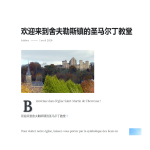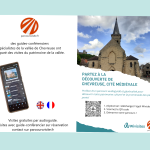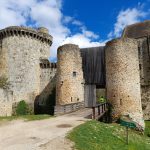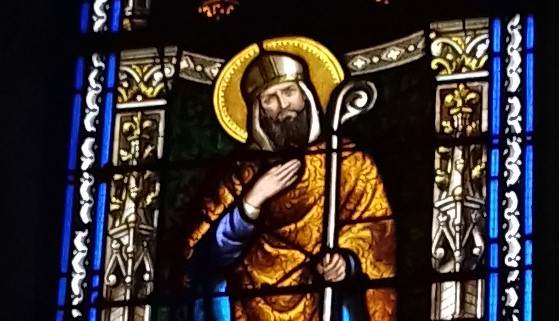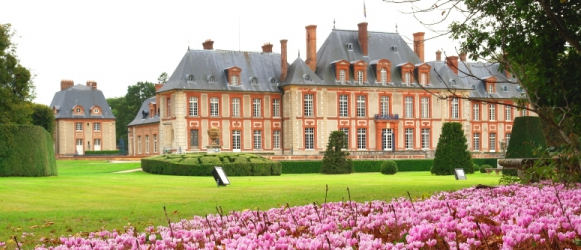The church at Dampierre is in the heart of the Valley de Chevreuse, 7km from the station of Saint-Remy.
 Having left Chevreuse, follow the route along the length of the Valley and leave the woods to arrive at Dampierre.
Having left Chevreuse, follow the route along the length of the Valley and leave the woods to arrive at Dampierre.
Now walk into the nave, where the people of God gather.
First built in the 13th century with millstones, the Church of St Peter was badly damaged during the Hundred Years War. It has been rebuilt several times. It was last restored between 1858 and 1867 when a new transept running along the west side of the church was added. This transept was decorated in the neogothic style, as was the vault.
The church is oriented in an east-west direction according to tradition. The sun rising in the east is, for christians, the symbol of the Risen Christ.
Originally, the choir was in the east side of the church, but it has been moved to the west. The two apses of the original choir have been brought down to build a porch opening onto the main street.
Turn left, where you can discover an impressive 19th century French painting of Saint John the Baptist.
 John the Baptist is identified by the camel’s skin which he wears, his raised finger, the lamb and the reed cross.
John the Baptist is identified by the camel’s skin which he wears, his raised finger, the lamb and the reed cross.
The skin refers to the fact that John the Baptist lived in the desert, and the finger to his announcement of the coming of Jesus, the ‘Lamb of God’. To the numerous disciples gathered around him John proclaims:
‘ I, indeed, baptize you with water unto repentance, but he that cometh after me is mightier than I, whose shoes I am not worthy to carry ; he shall baptize you with the Holy Ghost and with fire’. (Matthew, 3, 11)
Sit down for a moment in the central nave and face the choir.
 The altar is in the centre of the choir; it is the place where the sacred mystery of the Eucharist unfolds, in accordance with the words of Jesus :
The altar is in the centre of the choir; it is the place where the sacred mystery of the Eucharist unfolds, in accordance with the words of Jesus :
‘ Do this in the memory of me’ (Luke,22,19).
At each mass, Christ’s sacrifice is renewed during the Eucharist, when the bread and wine become His Body and His Blood, making Jesus fully present.
The red and white marble neo-Classical altar is inscribed with the four hebrew letters יהוה, the Tetragrammaton, which cannot be pronounced but which can be translated as ‘LORD’ (or Yahweh).
On both sides of this central altar are two smaller altars, dating back to the 18th century.
Take a closer look at the right one. It is the Blessed Sacrament altar, with the Tabernacle.
When the tabernacle holds hosts which have been consecrated during the Eucharist, a red lamp is lit to signal to all present the Real Presence of Christ.
 The Tabernacle is covered with a canvas which symbolises the tent which was carried by the Hebrews when they were in the wilderness. A transportable sanctuary, the tent was the special place where God could dwell among his People.
The Tabernacle is covered with a canvas which symbolises the tent which was carried by the Hebrews when they were in the wilderness. A transportable sanctuary, the tent was the special place where God could dwell among his People.
On the door of the Tabernacle, there is a Classical style design with the lamb, the scroll sealed with seven seals and a host in a cloud.
The Lamb is a symbol of Christ, reminding us of His sacrifice. But, on the Book, the lamb also refers to the Divine Lamb who broke the seven seals (the Apocalypse of Saint John).
The IHS monogram signifies the name of Jesus Christ, being the first three letters of his name in greek,
 The painting with Saint Peter, with the keys, refers to Evangelization.
The painting with Saint Peter, with the keys, refers to Evangelization.
After his Resurrection, Jesus told his disciples : ‘Go, therefore, and make disciples of all nations baptizing them in the name of the Father and of the Son and of the Holy Spirit’.(Matthew, 28,19)
Peter went to Rome, Irenaeus to Lyon, Saint Denis to Paris and Saint Martin evangelized to the french countryside.
Three stained glass windows, which used to be on the southern wall, were put in the choir in 1991 .
- The stained glass window, ‘the Virgin and Child’, reminds us that Virgin Mary gave birth to Jesus ; the Lily is a symbol of her purity. Mary holds her son Jesus while he holds up an orb in his hand, surmounted by a cross, representing the universe.
- The stained glass window of Saint Lucien shows him wearing the bishop’s mitre and supporting the bishop’s crosier. Born in Rome, Lucien was the first Bishop of Beauvais, a martyr, who died in 290 .
 On the stained glass window dedicated to Saint Louis, the saint is dressed in his role as King Louis IX wearing a Fleur de Lis Chasuble, with the hand of justice and the the royal crown. In his hands he holds a crown of thorns wrapped in a white linen cloth. The window recalls the christian roots of the monarchy in France and the King’s role in the reform of justice. In 1238, Saint Louis acquired in Constantinople the relic of Christ’s crown of thorns for which he had the renowned ‘Sainte Chapelle’ built in Paris.
On the stained glass window dedicated to Saint Louis, the saint is dressed in his role as King Louis IX wearing a Fleur de Lis Chasuble, with the hand of justice and the the royal crown. In his hands he holds a crown of thorns wrapped in a white linen cloth. The window recalls the christian roots of the monarchy in France and the King’s role in the reform of justice. In 1238, Saint Louis acquired in Constantinople the relic of Christ’s crown of thorns for which he had the renowned ‘Sainte Chapelle’ built in Paris.
0n the right, the stained glass window shows Saint Honoré with the mitre and Bishop’s crosier (of Amiens). This window was given by the Luynes family in 1877.
Continue walking towards the Lady altar on the left.
Next to the altar you will find a little polychromatic statue of Saint Expedit. And a switch to turn on the light.
 The marble statue of the ‘Virgin and child’ dates back to the 19th century; it is the work of the sculptor, Pierre Loison.
The marble statue of the ‘Virgin and child’ dates back to the 19th century; it is the work of the sculptor, Pierre Loison.
The altar is adorned with a gilded and painted wooden triangle with the Tetragrammaton surrounded by a cloud; the triangle symbolises the Divine Trinity.
Christians believe in one God in three persons – the Father, Son and Holy Spirit. The Holy Spirit is the Spirit of Love between the Father and Son. God has poured out his love into our hearts by the working of the Holy Spirit, whom he has given us.
The Holy Spirit is represented either by a dove or a cloud.
Walk back to the nave. The stained glass windows were made in 1991 by Emmanuel Chauce. The vertical axis shows the exchange between God and men, while the horizontal axis symbolizes the difficulty of the ascension to God.
 In the middle of the nave is a fine churchwardens pew which dates back to 1733, with the keys of Saint Peter.
In the middle of the nave is a fine churchwardens pew which dates back to 1733, with the keys of Saint Peter.
The churchwardens pew was for all the members of the Council of the Parish, administrative and financial.
At the back of the church is a confessional which dates back to the 19th century.
Before leaving the church go back to the Lady altar and find an impressive and beautiful 19th century bronze gate.
 This gate is the entrance to the funerary chapel of the Luynes family.
This gate is the entrance to the funerary chapel of the Luynes family.
In 1862, Honoré Théodoric, 8th Duke of Luynes, commissioned Joseph Frédéric Debarcq and Charles Garnier, to build a private funerary chapel for his family, with a crypt. These two young architects, with whom the Duke had worked when he was an archaeologist in Italy, went on to create other noteworthy structures – Charles Garnier built the iconic Paris Opera, the Opera Garnier.
Peering through the gates which remain locked, one can see against the right wall of the funerary chapel, a cenotaph surmounted by a white marble statue by Jean-Marie Bonassieux, depicting the Duchess of Luynes who died in 1861.
 Above the cenotaph is a statue of our Lady of Mercy and on the left is a statue of Saint Michael, with his sword and shield, symbolizing justice.
Above the cenotaph is a statue of our Lady of Mercy and on the left is a statue of Saint Michael, with his sword and shield, symbolizing justice.
Both were made by Alexis-Hippolyte Fromanger.
 At the back, a stained glass window depicting the Ascension of Jesus, the prophets, Moses and Adam and Eve, casts a dramatic light over the otherwise somber chapel.
At the back, a stained glass window depicting the Ascension of Jesus, the prophets, Moses and Adam and Eve, casts a dramatic light over the otherwise somber chapel.
On returning to the back of the church you will find a plaque which marks the place where a ‘relic’ is kept – a hand of Marie-Charles, Duke of Luynes, the much-loved benefactor of Dampierre, who died in 1771.
 The plaque recalls the Words of Jesus : ‘Love one another as I have loved you’.
The plaque recalls the Words of Jesus : ‘Love one another as I have loved you’.
The grateful inhabitants of Dampierre protected The Duke’s castle during the French revolution.
Furthermore, Marie-Charles’ son, Louis-Albert, 6th Duke of Luynes, had supported the ideas and aspirations of the Third Estate – the revolutionaries.
As you leave our village church, take a look at its outstanding bell tower. The oldest bell, called Mary, dates back to 1576. The tower was restored in 1862.
Open daily, the Church welcomes Christian believers and passers-by, especially hikers and cyclists exploring the beautiful Chevreuse Valley.
Everyday, morning, noon and night, you will hear the ringing bells of the Angelus; they have rung out since the 15th century. The Angelus reminds us of the Angel Gabriel giving Mary the message of the coming Messiah through her.
God bless you all!
(Dampierre leaflet HB-FD-MW EPVC)
Photos HB, popgouv
